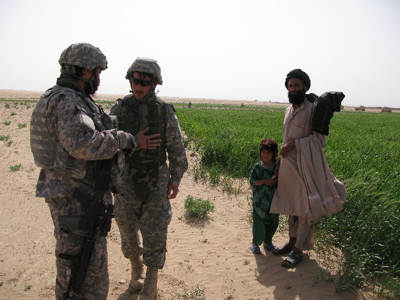On a bright March day, two members of an Army Human Terrain team in southern Afghanistan joined soldiers from the Second Battalion, Second Regiment of the First Infantry Division, known as Task Force 2-2, in a patrol to Pir Zadeh, the friendliest village in the unit's operating area.
A senior social scientist with the Human Terrain team, Dr. Karl Slaikeu, had asked for this patrol. He was looking for a village that, with concerted U.S. effort, could serve as a model of security and development, and he thought Pir Zadeh might be just the place. The Human Terrain team's mission was to get a feel for the area and meet the village elder, who seemed to like Americans.
Eight years into the war, the soldiers of Task Force 2-2 were the first international troops to patrol Maywand in significant numbers. The Human Terrain team was tasked with helping familiarize them with Afghan culture, agriculture, tribal politics and the vagaries of the local economy. Most days, the sand flats and wheat and poppy fields between the city of Kandahar and Helmand Province were deceptively quiet. It was easy for the troops to drift into complacency, to lose their edge. But that would have been a mistake. Maywand was a key transit area for fighters and drugs, and the Taliban controlled it, intimidating people who knew the local government couldn't protect them.
For the two Human Terrain team members joining the patrol to Pir Zadeh, Maywand was a place of known risk. The previous fall, a Human Terrain social scientist named Paula Loyd, a bright, big-hearted Texas blonde with degrees from Wellesley and Georgetown and years of experience as a soldier and aid worker in Afghanistan, had been interviewing villagers in Maywand when an Afghan man doused her with gasoline and set her on fire. Paula died in January, the third Human Terrain social scientist killed in the field in eight months. Karl Slaikeu, a 64-year-old psychologist and conflict resolution specialist from Austin, TX, had been sent to take her place.


























